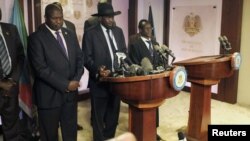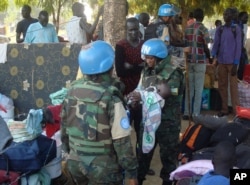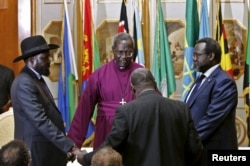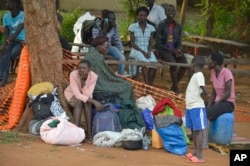South Sudan’s capital was calm Friday as government and opposition forces appeared to respect a cease-fire declared earlier in the week. The question of whether a peace deal signed last year can continue to work, however, remains.
The deal was severely tested when violence erupted in Juba on June 6, killing hundreds of people and sending opposition leader Riek Machar into hiding.
The five days fighting between those loyal to President Salva Kiir’s SPLA, and loyalists of First Vice President Riek Machar’s SPLA in Opposition, left at least 270 people dead and some 36,000 displaced.
The violence represented a major setback for the peace deal, signed nearly a year ago, which was intended to stop 20 months of fighting between the rival forces.
Despite relief brought by Monday's cease-fire, some analysts are skeptical it can hold.
“If this cease-fire is in fact more tactical than a genuine political commitment, that as both forces have a chance to reorganize and reassess where they are, I think that we could see renewed fighting,” said Susan Stigant, director of Africa programs at the United States Institute of Peace.
World Peace Foundation director Alex de Waal agrees that the cease-fire could be misleading in the quest for stability.
“The reason why we have a bit of a pause in Juba is that they did manage to inflict at least a tactical defeat on the SPLA in Opposition, but that doesn’t mean that there is peace and security throughout the country,” he said. “It doesn’t mean that the problems are resolved. I’m afraid we’re in for a very, very rough time.”
Underlying issues unresolved
Mawan Muortat, a South Sudan political commentator, says the current South Sudanese political landscape allows only for two people, Machar and Kiir, to serve as leaders.
He says his colleagues have suggested different approaches.
“Other people have been suggesting [that], perhaps, if both sides nominate someone else, Salva Kiir and Riek [could] step down simultaneously, allowing maybe for their deputies to take over," he said. "Maybe that would calm things down a little bit and maybe you could have a much better cooperative relationship toward completing the agreement.”
Other underlying issues remain unresolved, such as the ongoing dispute over the number of states in the country—which the peace agreement doesn’t outline—and the appointment of their governors by Kiir.
Cantonment sites for opposition forces also remain a point of contention.
Additionally, Kiir says he will not accept foreign soldiers in South Sudan, after the East African regional bloc IGAD suggested more were needed to help the U.N. mission there.
Humanitarian crisis loom
Although Juba’s fighting drew international attention this week, Human Rights Watch senior researcher Jehanne Henry urges that areas outside the capital not be forgotten.
“Well, I think Wau continues to be a flashpoint; I think Yambio and areas around it are also flashpoints," she said. "We documented real problems there earlier this year, as well. I think Yei and parts of Eastern Equatoria, there are actually several different places where we’ve heard about skirmishing.”
The humanitarian crisis across South Sudan appears to be worsening. The U.N. World Food Program said Friday that “food stocks are stretched,” a day after reporting that its main warehouse in Juba had been looted.
WFP officials also say the warehouse contained a month’s worth of food and nutritional supplies for 220,000 people.
President Kiir, who said he does not want further bloodshed, has called upon Machar to meet for talks in order to “chart the way forward.”
Machar’s exact whereabouts remain unknown, although he is believed to be outside of Juba but still in the country.
Unless both sides show the political willpower to abide terms of the peace agreement, some analysts said the country will face even more challenges in the days ahead.










